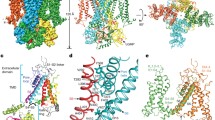Summary
Cilia isolated fromParamecium tetraurelia possess a specific, high affinity L-[3H]glutamic acid binding site, defined by an ED50 of 3.0×10−8 M. The structural specificity of this site was probed by testing the competition between L-glutamate and various analogues for binding to cilia. The binding site is stereo-specific for L-glutamic acid, and requires the presence of all three ionizable groups on the glutamate molecule for optimal ligand: receptor interaction.
Specific binding of L-[3H]glutamic acid to cilia is rapid in onset but transient, reaching peak values within 6 min, and then declining thereafter. This transience may represent a form of sensory adaptation during prolonged exposure to the ligand.
Similar content being viewed by others
References
Adoutte A, Ramanathan R, Lewis RM, Dute RR, Ling K-Y, Kung C, Nelson DL (1980) Biochemical studies of the excitalble membrane ofParamecium tetraurelia. III. Proteins of cilia and ciliary membranes. J Cell Biol 84:717–738
Aomine M (1981) The amino acid absorption and transport in protozoa. Comp Biochem Physiol 68A:531–540
Barber VC (1974) Cilia in sense organs. In: Sleigh MA (ed) Cilia and flagella. Academic Press, London, pp 403–433
Brugerolle G, Andrivon C, Bohatier J (1980) Isolation, protein pattern and enzymatic characterization of the ciliary membrane ofParamecium tetraurelia. Biol Cellulaire 37:251–260
Bumann J, Malchow D (1986) Cyclic AMP-induced reversible decrease in cAMP-binding to cell surface receptors inDictyostelium discoideum. FEMS Microbiol Lett 33:99–103
Caprio J (1984) Olfaction and taste in fish. In: Bolis L, Keynes RD, Maddrell SHP (eds) Comparative physiology of sensory systems. Cambridge University Press, New York, pp 257–283
Christensen HN (1972) Nature and roles of receptor sites for amino acid transport. Adv Biochem Psychopharmacol 4:39–62
Csaba G, Madarasz B (1979) Localization of concanavalin-A binding sites inTetrahymena by scanning EM. Experientia 35:1181–1183
Csaba G, Sudar F, Nagy U, Dobozy O (1977) Localization of hormone receptors inTetrahymena. Protoplasma 91:179–189
Dunlap K (1977) Localization of calcium channels inParamecium caudatum. J Physiol 271:119–133
Eckert R (1972) Bioelectric control of ciliary activity. Science 176:473–481
Fukushi T, Hiwatashi C (1970) Preparation of mating reactive cilia fromParamecium caudatum by MnCl2. J Protozool 17:21A
Foster AC, Fagg GE (1984) Acidic amino acid binding sites in mammalian neuronal membranes: their characteristics and relationship to synaptic receptors. Brain Res Rev 7:103–164
Hazelbauer GL, Harayama S (1983) Sensory transduction in bacterial chemotaxis. Int Rev Cytol 81:33–70
Klein C, Lubs-Haukeness J, Simons S (1985) cAMP induces a rapid and reversible modification of the chemotactic receptor inDictyostelium discoideum. J Cell Biol 100:715–720
Kovacs P, Csaba G (1980) Detection of histamine binding sites (receptors) inTetrahymena by fluorescence technique. Acta Biol Med Ger 39:237–241
Kung C (1979) Biology and genetics ofParamecium behavior. In: Breakefield XO (ed) Neurogenetics: genetic approaches to the nervous system. Elsevier, New York, pp 1–26
Machemer H, Ogura A (1979) Ionic conductances of membranes in ciliated and deciliatedParamecium. J Physiol 296:49–60
Ordal GW (1985) Bacterial chemotaxis: biochemistry of behavior in a single cell. Crit Rev Microbiol 12:95–130
Oxender DL (1972) Amino acid transport in microorganisms. In: Hokin LE (ed) Metabolic pathways (vol VI). Academic Press, New York, pp 133–185
Preston RR (1983) Studies on the responses ofParamecium tetraurelia to amino acids. PhD Thesis, University of Nottingham
Ramanathan R, Adoutte A, Dute RR (1981) Biochemical studies of the excitable membrane ofParamecium tetraurelia. V. Effects of proteases on the ciliary membrane. Biochim Biophys Acta 641:349–365
Rhein LD, Cagan RH (1981) Role of cilia in olfactory recognition. In: Cagan RH, Kare MR (eds) Biochemistry of taste and olfaction. Academic Press, New York, pp 47–68
Usherwood PNR (1978) Glutamate receptors in eucaryotes. Adv Pharmacol Therapeut 1:107–116
Wyroba E, Przelecka A (1973) Studies on the surface coat ofParamecium aurelia. I. Ruthenium red staining and enzyme treatment. Z Zellforsch 143:343–353
Yonekawa H, Hayashi H (1986) Desensitization by covalent modification of the chemoreceptor ofEscherichia coli. FEBS Lett 198:21–24
Author information
Authors and Affiliations
Rights and permissions
About this article
Cite this article
Preston, R.R., Usherwood, P.N.R. Characterization of a specific L-[3H]glutamic acid binding site on cilia isolated fromParamecium tetraurelia . J Comp Physiol B 158, 345–351 (1988). https://doi.org/10.1007/BF00695333
Accepted:
Issue Date:
DOI: https://doi.org/10.1007/BF00695333




